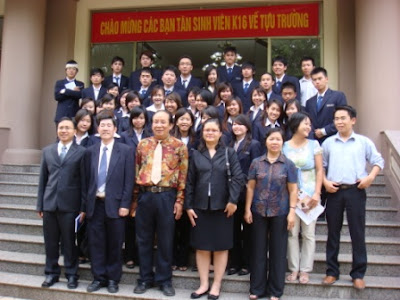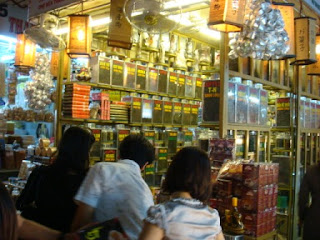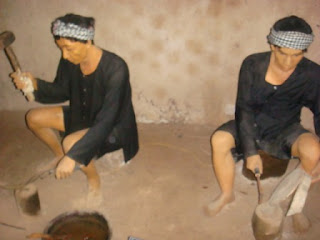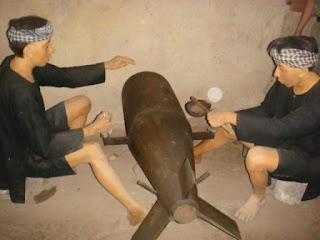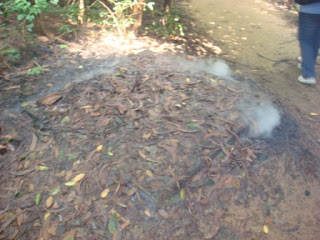When we have reached Hanoi, our Vietnamese tour guide, Kanh, brought us to a Vietnamese restaurant to have Vietnamese cuisine dinner with local cultural show.
On our way to the restaurant for dinner, Kahn taught us some simple conversational Vietnamese. For example, “cam on” means thank you, “bao nhieu” means how much, etc.
When I entered into the restaurant, I was quite surprised by the environment. The furnishing of the restaurant and the decorations (i.e. every table is beautifully decorated with flowers and red cloth) has created a very nice ambience.
The reason why I was surprised is because before I went to Vietnam, I have a perception that Vietnam is not a very developed country, therefore the places there will not appear very ‘nice’ to me; dirty, dark, not well furnished. However, my perception turned out to be negative.
I have also noticed that there was a small group of Vietnamese ladies dressed up in traditional Vietnamese costumes sitting near the exit of the restaurant playing some musical instruments. These instruments appeared to me like some of the Chinese musical instruments. Later, I realized that the pieces they played sound very familiar; the songs they played were actually the Chinese oldies. The combination of the ambience and the songs has made me feel like I am at home; it is very comfortable.
When we started having our dinner, a few of the Vietnamese ladies except those who were playing the instruments, came to each of our table wanting to sell us souvenirs.
Initially, I was quite puzzled as I did not know why the Vietnamese ladies could play Chinese musical instruments. Later, then I realized that the reason maybe because of the long period of Chinese Occupation in the early days where the Vietnamese were influenced by the Chinese culture to a certain extent.
Wednesday, October 31, 2007
Arrival at Hanoi
Temple of Literature (Van Mieu or 文廟)
Temple of Literature is also called Van Mieu in Vietnamese and 文廟 in Chinese. It is founded in 1070 as a Confucius temple. In 1076, the first university of Vietnam was established within the temple for the royal family members and was later opened to talented students.
Talented students were then offered a chance to study in the school. In order to get a title given by the emperor to work for the government, they have to pass the imperial exams. The emperor will then crave the names of the graduates on the stone steles, which were placed above the stone turtles. However, those who do not have any contribution, their names will be scraped off from the stele.
There are ponds in the temple and many trees in the temple. The reason for their existence in the temple is because of ‘feng shui’ (風水). From the viewpoint of ‘feng shui’, ‘yin’ represents tree while ‘yang’ represents pond. ‘Yin” and ‘yang’ should always exist together to have a balance. That is the reason why trees and ponds can be found in the temple.
Initially, I thought that the purpose of having ponds and trees there was to beautify the temple. Thus, I was quite surprised when I found out that it was meant for the ‘feng shui’. I was even more surprised that the Vietnamese believed in ‘feng shui’ as all the while I thought that only the Chinese would believe in such things. Therefore, in this trip to the Temple of Literature, I have learnt additional thing that is the impact of Chinese cultural on the Vietnamese; it has affected the Vietnamese to a certain extent in terms of their belief.
The temple consists of 5 courtyards. There were 3 gates to the second courtyard of the temple which is the main hall. The gate in the center is much bigger than the other 2 gates at the side. In the past, the 3 gates were meant for different people. The gate in the centre was meant for the King while the one to its left was for administrative Mandarins and the one to its right was for military Mandarins.
I was told by Kah about an old man & 3 animal’s story.
An old man tried his best to bring up 3 animals which are the crane, snake and turtle. When they grew up, the old man became even older and could no longer do anything for them. Therefore, the snake and turtle decided to kill the old man for food. When the crane heard of this, it killed them for the old man. The morale of the story is to let us know one of the Chinese idioms which is ‘yin shui si yuan’. This means that one should be grateful to the people that have taught, helped and /or brought him/her up.
Hanoi Open University (HOU)
HOU was established in 1993 under the decision of the Prime Minister of Vietnam. It was set up for higher education and training with different forms of training to meet the various learning needs of the society. There are 2 modes of training available in HOU; face-to-face training (10,000 students) and distance training (20,000 students throughout the country).
The university offers 8 academic faculties; Economics and Business Administration, Foreign Languages, Information Technology, Tourism, Design, Law, Bio and Electronics. There are a total of 8 campuses for the 8 faculties. The campus which we visited was for the faculty of economics and business administration.
Economic and accounting students are compulsory to learn English. There are 30 credits for English and 10 credits for English for special purpose (ESP). ESP certificate is very useful in helping the students to apply a job.
The university does not offer its students any overseas attachment however there are students from neighbouring countries like Laos who come to the school and study. And HOU has established cooperation with universities/institutes from Thailand, China, Malaysia, etc. They have cooperation activities which are in the form of exchanges of academic information and materials, staff and students, joint research projects, conferences, seminars and training programs.
The university has facilities like computer labs and library for the students to use. However, I feel that those are quite insufficient as I think that university students should have more facilities. The faculties that HOU offers are very specialized, so I think that the school should provide more “in-dept facilities” in each of the faculty. For example, in the faculty of law, the school can probably built an “in-house court” for the students to practice and have a rough idea of what the actual court session is like. And in the faculty of bio, the school should have a lab for them to do their practical stuffs.
I have also noticed that the students there are very enthusiastic and are very interested about the things in Singapore & the education system. Most of them aren’t shy about asking us questions and I think that it is good as they are able to learn and know more by asking questions. And I think that most of them are very talented and intelligent. Given a good education system in Vietnam, a lot of them will outperform many of us.
Currently, education is very important in Vietnam. I have learnt that the rich Vietnamese are willing to spend on their children’s education more than anything else. And the companies in Vietnam are also looking towards a more ‘educated workforce’ whereby they mostly hire a university graduate who is able to speak English. That is the reason why schools in Vietnam like HOU are enforcing rules for the students to speak English. I think that the education industry is a very prospective industry to go into now.
My Tho & Unicorn Island
The visit to Unicorn Island was a brand new learning experience for me.
Unicorn Island is considered one of the rural areas in Vietnam. The people lead a simple life there. They make candy, embroidery products, hats, etc. and sell to make a living. The main modes of transportation in the island are bicycles, motorbikes and sampan. In this modern era, most of us are living in a fast pace & high technology environment. Maybe because of that, such simple environment has become one of the tourist attractions where I can see many other tourists in the island.
After we have reached the Unicorn Island, we were being brought to a place where we were served with different kinds of fruits like pineapple, banana, rambutan and longan, tea was also served. I believed that the fruits were planted by the villagers. While we were enjoying the fruits, there were a few Vietnamese started to play some musical instruments. I recognized two of the instruments; one of them is guitar and the other which is one of the famous Chinese instruments call ‘gu zhen’. I do not know what the other instrument is called but it appears to me like one of the Chinese instruments too. While they were playing, there was a Vietnamese lady began to sing. She sang in Vietnamese thus I believed that it should be one of the traditional Vietnamese songs.
We visited a shop where the people made coconut candy and sell. After the coconut has cut into half or pieces, it will be thrown to a simple equipment where the coconut juice will be ‘squash out’ and they will start making the candy.
Besides making candy, the villagers also made hats, embroidery products, etc. to make a living. They are very skillful as they made many products using their hands and/or simple tools. However, this also means that they are not very high tech as all these products could be produced using machines instead of using hand which is much faster & efficient.
And maybe because that they are limited in terms of machines & technology, they will always think of making certain products using simple tools or using a thing (e.g. fruits) to make several products. For example, coconut can be used to make many other things like coconut candy, coconut husk ornament (craved to some animal characters like the monkey).
Later on, we were brought to another place where the people there make rice paper for a living. 2 of our students, Mua Hwee and Edna tried to learn to make rice paper from them. They tried and it turned out to be quite successful.
The sampan ride was a very unique experience to me as never in my life have I travel on a sampan before. The ride was very peaceful & relaxing. During the ride, I thought to myself, “how come a life could be so simple; by rowing a sampan to earn a living.” I suddenly admire them for a moment as I think that it is impossible to lead such a simple life in Singapore; life in Singapore is fast pace and hectic. From that moment, I saw a drastic difference in the lifestyle between them and the Singaporeans.
The trip to Unicorn Island has made me change my perception of the Vietnamese; they are actually very innovative & skillful people. And I believed that if these people are under proper training & education, they will surpass many Singaporeans who are the “methodology” people that do not possess certain factors which the Vietnamese possess. I believed that it is because of the different environment that we are being brought up from.
Ben Thanh Market
Ben Thanh market is one of the famous landmarks in HCMC. It has been in existence since the French occupation. Ben means pier or port and Thanh means fort. The original market was located on the shores of Ben Nghe river by old fort Gia Dinh. The market was destroyed in 1859 when the French invaded HCMC. However, it was rebuilt shortly and then moved to the present location in 1899.
The market sells all sorts of things like clothes (ranges from traditional Vietnamese costumes (‘ao sai’) to trendy tee shirts), food (crackers, cashew nuts, coffee powder, tea leaves, etc.), souvenirs, handbags, shoes, teapot sets, etc. It also sells what normal wet market sells like fish, vegetables, meat, etc. To me, it is like a place to shop and buy groceries. I call it the “all in one market” where one can buy almost anything in the market.
As most of the shops sold almost the same things, thus there was competition among them. Buyers like us could go around different shops in the market and ask for the cheapest price, thus in order to earn a profit, they would have to give us a good price. However, it has become one of the tourist attractions thus I feel that somehow or rather the shop owners have already agreed in a range of prices in their products. So even if you go to other shops and asked for prices, it would be within a range (about the same).
In this trip to Ben Thanh market, I have acquired bargaining skill. Bargaining skill is required when you shop there. And there is one simple principle you have to know when you are bargaining with them, that is: “buy more and you will have more discounts”. Thus, our favourite line when we are shopping there would be, “Aunty, give us more discounts la! See! So many of us buy from you. More discounts la.”
The things sold in Ben Thanh market are cheaper than in Singapore. I think that shopping is fun with bargaining. I do not know about the guys. However, I think that most of the girls would share the same sentiment as me and that is we would get a sense of satisfaction if we were managed to bargain to the price we want.
Cyclo Tour
Cyclo tour has brought me to another side of Ho Chi Minh City from the earlier visit to the Unicorn Island. In certain part of the city, there are many beautifully lighted up buildings and 5 stars hotels. It looked like a vibrant city, just like Singapore; where the night is always brighten up by beautiful lights from the buildings.
This has also showed a drastic difference between Hanoi and HCMC where the night in Hanoi is not as lively as the night in HCMC partly because of the lightings from the buildings and also the people. There are much more foreigners in HCMC than in Hanoi where their nightlife are always very happening.
During this cyclo tour, I had a real close experience with the heavy traffic in Vietnam as we are on the trishaw which traveled on the road together with the traffic. The traffic is really heavy and vehicles are horning their way through the traffic. Whenever the trishaw rider is changing lanes to make a turn, I’ll always hold my breath for a moment as it is really scary when you are so close to the traffic and you are unprotected with anything; no safety belts, nothing! Scary! However, it was an unique experience for me and I have enjoyed the ride!
Cu Chi Tunnel
In the past, Cu Chi tunnel was a war place between the Vietnamese and the Americans. It is a distinctive architecture; network of underground dug-outs of 75-mile-long, consisting of many layers and turnings with living, meeting and fighting quarters for the NLF fighters (guerrillas). In order to hide from the attacks by the American soldiers, the guerrillas dug the tunnel. The reason why the tunnel is so long is because of survivor instinct; the guerrillas keep digging the tunnel to avoid the US army. The tunnel has been preserved by the Vietnam government, and they have turned it into a war memorial park which is a popular tourist attraction now.
During the visit to Cu Chi tunnel, we are allowed to crawl into the safer parts of the tunnel system and the some tunnels were made larger to accommodate some of the tourists who are bigger in size. As the tunnel is very dark thus low power lights have been installed inside to make it easier for the visitors when they are inside. This means that the tunnel which we crawled is of much smaller size and darker in the past.
Besides the tunnel itself, they are also other attractions which include vendors selling souvenirs, a firing range where we pay about US$1 a bullet to shoot AK-47 rifle and some of the quarters where the guerrillas cook their food, make their bombs and weapons during the wartime.
Entrance to Cu Chi Tunnel:
Firing Range:
Weapon Making Quarters:
We also saw holes which are the result of the bombing by the B52 bombs. Besides that, we saw bobby traps like the door traps, window traps, etc. which were created by the guerrillas to trap and kill the American soldiers on the spot.
Some traps:
1. Door Trap
2.Sticking Trap
3. Klipping Armpit Trap
4. Window Trap
5. Fish Trap
6. See-Saw Trap
Before we left the place, we have also enjoyed a simple meal of food that guerrillas have eaten in the past during the wartime. The food consists of steamed tapioca and tea.
I have developed a new image about the Vietnamese. I think that they are very smart; not only did they create bobby traps, they also think of ways to avoid being discovered when they are cooking and after answering the nature call.
They actually dug a hole for their “big business” and used ash to absorb the smell to prevent from being discovered by the American soldiers who used dogs to detect the traces of guerrillas. The smoke created from cooking was spread all over the forest which made it difficult for the American soldiers to track them down. They also used termites’ holes as their air holes for breathing so that the dogs cannot detect them.
I have been down to the tunnel and it was small and stuffy, I am really amazed on how the guerrillas managed to survive through the tiny tunnel during the war. One of the reasons of building small tunnel is to prevent the Americans soldiers who are bigger in size from entering the tunnel.
All these have showed the strong survivor instinct that they possessed and how smart they are. I think that they are not only smart and also very meticulous about everything during the war as we all can see during the visit.









